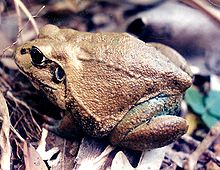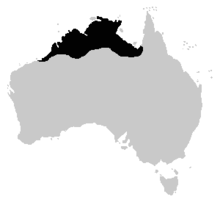- Cyclorana australis
-
- The unrelated Southeast Asian Blyth's River Frog (Limnonectes blythii) and the African Goliath Frog (Conraua goliath) are occasionally also called "giant frog".
Giant Frog 
Conservation status Scientific classification Kingdom: Animalia Phylum: Chordata Class: Amphibia Order: Anura Family: Hylidae Genus: Cyclorana Species: C. australis Binomial name Cyclorana australis
(Gray, 1842)
Range of the Giant Frog Cyclorana australis, commonly named the Northern Snapping Frog or Giant Frog, is a burrowing species native to Australia. It occurs from western Queensland through to northern Western Australia.
Contents
Physical description
This is a large frog reaching up to 100 mm in length. They are variable in colour and patterning, adults range grey to dull pink to green or more commonly brown on the dorsal surface, occasionally with darker markings. The skin on the dorsum has low warts and two longitudinal skin folds with a second pair on the flanks. The belly is white and finely granular. There is a dark brown streak that starts from the tip of the snout and runs, through the tympanum and ends over the shoulder. There is a similar coloured bar under the eye and another that runs the length of the upper jaw. The tympanum is partially covered with a skin fold and is distinct. The back of the thighs range from flesh coloured to dark blue and the groin is a pale blue-green colour. The toes have a slight webbing and fingers are free from webbing.
Ecology and behaviour
This species inhabits floodplains, woodlands and grasslands. During the wet season it is commonly found during the day basking beside breeding sites, including temporary ponds, creeks or flooded areas. The males can be heard making a short "unk" sound from late November through to February. Eggs are laid in clumps of up to 7000 but more commonly 100 -1000. They sink soon after being laid.
Similar species
This species may be confused with New Holland Frog or the Striped Burrowing Frog. It can be distinguished from the Striped Burrowing Frog by the longitudinal skin folds and from the New Holland Frog by the colouration on the back of the thighs.
References
- Barker, J.; Grigg, G.C.; Tyler,M.J. (1995). A Field Guide to Australian Frogs. Surrey Beatty & Sons.
- Cogger, H.; Reptiles and Amphibians of Australia. - "Cyclorana australis" p. 89
- Frogs Australia Network - Giant Frog
This Pelodryadinae article is a stub. You can help Wikipedia by expanding it.

